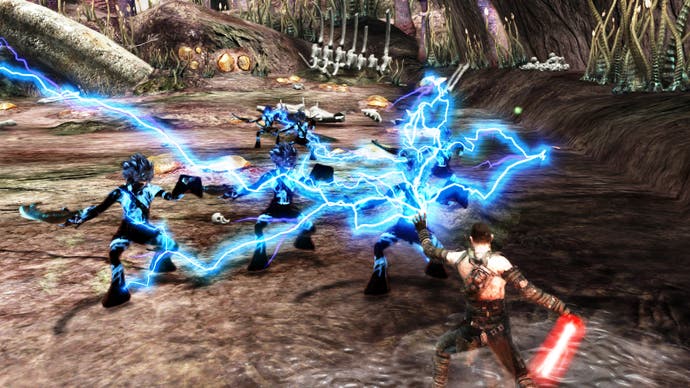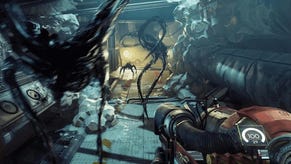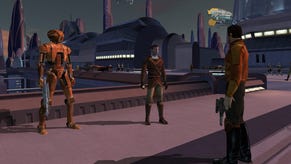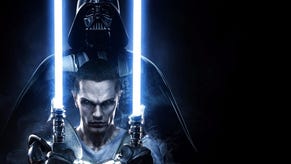Star Wars: The Force Unleashed
Delusions of grandeur?
With Force Grip, your projectiles can range from small crates, rocks and droids to huge boulders, large structures, and great chunks of vegetation. But there are few things as pleasing as grabbing a Wookiee or a Stormtrooper and swishing them around in mid-air as their limbs flail wildly, before either shooting them skywards, into each other, or frying them with Force lightning before smashing them into the ground. And there is something indescribably wonderful about plucking a soaring TIE Fighter out of the sky and dragging it to its destruction.
The controls are mostly slick: you grab on to a locked-on item using the right trigger on 360 (the version reviewed here). Then it's the left stick to move the object backwards and forwards, and the right stick for up and down. You can either set it down gently by releasing the trigger, or point in the desired direction and release to fling it. While it works most of the time, this latter option proved frustratingly hit and miss on occasion - with objects flying off in anything but the direction intended, seemingly locked-on to an enemy elsewhere in the area.
What works at a distance, does start to go a bit wrong up close. Trying to use Force Grip in the heat of battle in a confined space can become an irritating exercise in chance thanks to a temperamental auto-locking mechanic. And the illogically fixed camera angles used during several boss fights only exacerbate the problem. Still, overall, the moments of Force-flinging delight outweigh these gripes.
Lightsaber combat is less rewarding and rarely rises above mindless button-bashing. It's initially satisfying (what's not to like about cutting down hordes of walking carpets with your laser sword?) but ultimately shallow.
LucasArts' solution is to provide numerous moves to learn via the upgrade system, accessed via button-combos. But while some of these look cool, there's little strategic depth: it's still button-bashing, however you dress it up. At this point it will boil down to how you choose to play: you may want to unlock absolutely everything and use a different attack on every enemy you encounter. No doubt you'll glean enjoyment from that, but it won't materially facilitate your progress through the game.

I hate Quick Time Events. You may not, but in any case you should know The Force Unleashed is riddled with them. Every boss battle ends with a small series of tediously unchallenging button sequences to match, so your foe can be despatched with a scripted flourish. I understand the dramatic purpose behind QTEs, but as a gameplay substitute they stink. When you're too busy focusing on the symbols to watch large chunks of the directed sequences, what exactly is the point?
More disappointing, though, is the reliance on QTEs for some of your more challenging foes in general gameplay (of which there are many). What is a dramatically acceptable way of tying up a major game moment becomes an annoying distraction mid-level. This is a game that gives you incredible powers with which to manipulate your environment in ever more creative ways, and then repeatedly snaps you out of the action to idly stab at a few buttons so it can show the sequence where you chop the AT-ST in half again.
Doubtless there are balancing reasons behind this but, given the technology driving the game, it seems a shame the designers couldn't come up with a workable way for our apprentice to, say, pull apart an AT-ST in real-time.
Balance is probably the main issue with The Force Unleashed. As highlighted in the opening mission, your kick-ass powers can devastate scores of enemies with little effort. So to create challenge, the developer seeks to overwhelm the player with numbers; in the game's larger spaces you will routinely be faced with enemies attacking you from all sides.

For example, in an Imperial hangar you might have around 20 Stormtroopers gunning for you - some energy-shielded and packing deadly rapid-fire weapons. Meanwhile there's an AT-ST stomping around, using a gravity gun to chuck metal crates in your direction, while snipers on a higher level take potshots with laser-guided rifles. The only way out is to use your Force powers on a door lock and, as it stands, you can't stand still for more than a couple of seconds.
At times like this, The Force Unleashed is magic: the sheer volume and variety of enemies clashes with your own explosive dark powers to produce some wonderfully intense, memorable encounters. If only more of the game played out at this level. And it's during the outdoor stages that you begin to realise how much trickery is involved.
When you have room to manoeuvre, the game's generally low difficulty is all too apparent. The scale and detail of the environments are regularly stunning; the flipside is that you can see groups of enemies and target them from afar with projectiles before they even remember they're holding guns, allowing you to clear the way ahead without breaking sweat.








